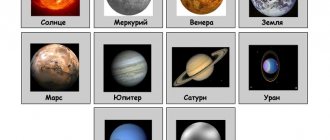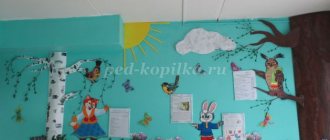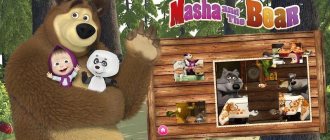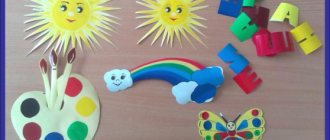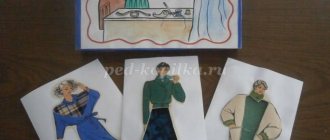Creativity corner for children of senior preschool age article (senior group)
GBDOU kindergarten No. 7
Krasnoselsky district of St. Petersburg
Senior teacher
Tushevskaya Olga Valentinovna
"Creativity Corner"
The subject-development environment is organized so that every child has the opportunity to freely do what they love. Placing equipment by sectors (development centers) allows children to unite in subgroups based on common interests. A rich subject-developmental and educational environment becomes the basis for organizing an exciting, meaningful life and all-round development of each child. The developing subject environment is the main means of shaping the child’s personality and is the source of his knowledge and social experience.
When creating a “creativity corner” the following tasks are solved:
- Create an atmosphere of emotional comfort
- Create conditions for creative self-expression
- Create conditions for the manifestation of children’s cognitive activity
- Create favorable conditions for perception and contemplation, draw children’s attention to the beauty of nature, painting, arts and crafts, book illustrations, music
A “creativity corner” in the senior group can be created under the motto “Feel – Cognize – Create.” It presents:
Materials for artistic and aesthetic activities, their variety:
- Paints (watercolor, gouache), plasticine, pencils, wax crayons, colored paper of various formats and textures, cardboard, brushes (squirrel or kolinsky) thin, medium and thick; rags for hands and hands, paint palettes, aprons, sippy cups for water, modeling materials.
- Easel
- Literature on art, postcards and albums for viewing. Reproductions, paintings, portraits of artists, small sculptures, works of decorative and applied art (haze, Gzhel, Khokhloma and others).
- Various didactic games for familiarization with: genres - still life, portrait, landscape; with painting, graphics, decorative and applied arts, architecture; with flowers and their shades.
- Natural and waste material
- Musical instruments, toys, technical equipment
- Games and attributes for theatrical performance. These are not only materials characteristic of the theater (screens, dolls, costumes, and so on), but also some materials for familiarization with the environment, fiction. There are also “theatres” and characters made by the children themselves during art classes. Theatricalization includes: table theater, sets of dolls, costumes, books, materials for decorations.
Materials for educational activities
- Nature calendars, collections
- Sensory Education Materials
- Visual material, games, aids to familiarize yourself with the world around you
- Fiction and encyclopedic literature
- Didactic and educational games
- Educational games, technical devices and toys, models, items for experimental research work - magnets, magnifying glasses, springs, scales, beakers, etc.; a large selection of natural materials for studying, experimenting, and making collections
- Table for experimenting with water and sand
The “Creativity Corner” is located in a well-lit and accessible place, where students in their free time draw, sculpt, do appliqué work, explore, and transform themselves into fairy tale heroes. It is a place for children's self-development. The group in the “Creativity Corner” combines various types of activities: drawing, modeling, familiarization with musical instruments, theatrical performances, research and experimental activities, work with natural materials, and familiarization with literature.
The “Creativity Corner” is always an actively working area that helps preschoolers develop an interest in making their own crafts, inventing fairy tales and stories, and studying science.
The creativity corner in kindergarten allows you to create optimal conditions in the group for the development of visual activity, independence and creative activity of children. Children get the opportunity to express themselves in various types of artistic and design activities, get acquainted with the world around them, and learn the properties of objects.
Decorating a corner in the junior group of a kindergarten with your own hands: Russian folk art
Decorating a corner in the junior group of the kindergarten “Russian Folk Art”
Author: Beloglazova Elena Aleksandrovna, teacher of the kindergarten “Alyonushka”, Novokuibyshevsk, Samara region. Description: this publication will be of interest to kindergarten teachers. Goal: Decorating a corner in the junior group of the kindergarten “Russian folk art” Objectives: - to introduce younger preschoolers to the origins of Russian folk art; — to involve parents of pupils in the design of the corner - “Russian folk art” My work as a kindergarten teacher began in the junior group, we got the group after kindergarten graduates, so the important point was the design of the group, the creation of a subject-spatial environment that would be comfortable and met the age requirements of children. Dear colleagues, I propose to your attention the design of the “Russian Folk Art” corner in the group. We all understand the importance of introducing children to the origins of national culture from an early age. Having explained to the parents of the pupils the importance of this area in the development and upbringing of their children, having received their approval and support, we began to design the corner. We allocated a place in the group so that it was open and accessible to children, and started decorating. Since the birch tree is a symbol of our Motherland, people wrote songs, proverbs and sayings about it, I chose it to decorate the wall. The birch trunk is made of whatman paper, which I bent and decorated, the leaves on the trees are made from ready-made decorative decorations, artificial leaves that I inserted on top.
As you can see, the first Russian antiquities appeared on the shelf: this is a samovar, which was given to us by the grandmother of one of the pupils, on which we hung a bunch of drying sacks. Next to the samovar we placed a loaf of salt dough made by our parents, (the loaf in the photo below) appeared jars, wooden spoons, and a matryoshka doll. And of course, the main decoration of the corner is our Russian beauty, in a red sundress, who is rightfully considered the owner of the corner, she was also given to us by our parents.
Our corner continued to take shape, and soon a Russian beauty appeared on the wall, leading a round dance around our birch tree. We designed the inscription for the corner “Russian folk art”, the letters were cut out of colored paper and glued to tape.
Soon, Russian folk instruments appeared in our corner: balalaika, accordion, bells, pipe, etc.
So gradually our corner was transformed. Due to new fire safety requirements, we slightly changed the design on the wall, we left the birch symbol, but now we painted two birch trees with paints, the inscription on the corner was also made with paint. Now our corner looks like this:
Together with parents, we continue to replenish and enrich our corner. For children, a folder was created with drawings for Russian folk tales, which were made by parents and children at home. Children love to look through the folder with drawings while in the corner and share their impressions of which fairy tale they like painted with my parents.
Here are some works: Fairy tale “Snow Maiden”
Fairy tale "Bubble, straw and bast shoe"
Fairy tale "Kolobok"
Together with my parents, poems and nursery rhymes about the nesting doll were decorated in the corner, in the form of a collection of “Matryoshka’s poems and nursery rhymes,” which I read to children during special moments.
This is not the end of the design of the “Russian Folk Art” corner in our group; we continue to replenish it and expand the material. I would be very grateful to hear your wishes and recommendations. Thank you all for your attention!
We recommend watching:
Physical education and health corner in kindergarten Do-it-yourself group and reception room decoration Welcome corner in kindergarten Do-it-yourself nature calendar in kindergarten
Similar articles:
DIY Autumn panel
How to organize a corner for artistic and aesthetic development
“How to organize a corner for artistic and aesthetic development”
Consultation for preschool teachers
The modern system of preschool education tells us about the need to introduce new forms and methods of work. The implementation of the Federal State Educational Standard is aimed at psychological and pedagogical support for positive socialization and individualization, the development of children’s personality and the implementation of an individual approach to each child.
One of the most important factors in the artistic and aesthetic development of a child in a preschool educational institution is the subject-spatial developmental environment. It is important for the development of the child, for creating aesthetic, emotional and psychological comfort in the institution. According to the Federal State Educational Standard for preschool education, the artistic and aesthetic development of preschool children involves the development of the prerequisites for the value-semantic perception and understanding of works of art, the natural world, the perception of music, fiction, folklore, and the implementation of independent activities of children.
The subject-spatial environment, in this case, acts not only as a condition for the creative self-development of the child’s personality, but also as an indicator of the teacher’s professional creativity, since its formation requires the teacher’s imagination and various methods of creation.
Artistic and aesthetic education is implemented by different types of art and artistic and aesthetic activities. It is aimed at developing a child’s love for beauty, enriching his spiritual world, developing perception, figurative ideas, imagination, aesthetic feelings, aesthetic attitude to the surrounding reality, as well as introducing art as an integral part of spiritual and material culture, an aesthetic means formation and development of the child’s personality.
A developing subject-spatial environment provides the opportunity for communication and joint activities of children and adults; according to the Federal State Educational Standard, it must be content-rich, transformable, multifunctional, variable, accessible and safe.
For comprehensive development, various activity centers for children are used.
Theater corner: an important object of the subject-development environment, since it is theatrical activities that help to adapt, unite the group, and unite children with an interesting idea. The educational possibilities of theatrical activities are wide. By participating in it, children get acquainted with the world around them in all its diversity through images, colors, sounds; Speech develops and improves, the sound culture of speech and its intonation structure are activated, fulfilling its corresponding role, the child inevitably practices clear, clear expression. The theater center needs to include different objects.
Requirements for the corner of fine art activities in accordance with the Federal State Educational Standards of preschool education
REQUIREMENTS FOR THE CORNER OF ART ACTIVITIES IN ACCORDANCE WITH FSES DOO
Prepared by:
teacher of MBU D/S No. 139 “Oblachko”
Kuritsyna T.I.
Thematic zones in the group are a prerequisite for the harmonious all-round development of preschoolers. The richness of their content, together with suitable design, will allow children to gain a great experience during their stay in kindergarten. One of the favorite activities of both younger and older preschoolers is drawing, which contributes to the creative development of preschoolers. And the child will be able to find a suitable activity in the art corner, which the teacher will equip specifically for this purpose.
The purpose of this
corner of visual arts
is to develop children’s creative potential, develop interest in artistic activities, form aesthetic perception, imagination, artistic and creative abilities, independence, and activity.
Requirements for the creation and design of an art corner
According to the modern educational standard (FSES), the design of the fine art zone in a group must meet the following requirements.
- Compliance with sanitary and hygienic requirements.
The corner is located in a well-lit place (near the window). Furniture must be appropriate for the height of children
- Equipment meets the needs of this age
. After all, each age category is unique. For example, younger preschoolers are in the process of adaptation, so the teacher does not need to change the design often. Children's attention should not be distracted by unnecessary details. In addition, the art corner should contribute to the development of children's sensory skills. At an older age, conditions for self-expression are more important. Materials for creativity and aesthetic development (for example, picture albums) should be freely available to preschoolers so that they feel like “masters” in the group.
- High aesthetics
. A good corner attracts children's attention with its beautiful design. The guys should feel comfortable there and experience aesthetic pleasure. “Children’s” design is important - the inclusion of game characters (pictures and dolls) and creative works of students in the design.
- Multifunctionality.
The gaming environment can be modified depending on the learning situation and combined with other zones. After all, groups are not very large rooms, so every meter must be used rationally. Equipment and materials must be easily transformed to create a new game. For example, with the help of the Fine Arts corner, you can organize a role-playing game “In the artist’s workshop” (combined with the theatrical corner).
- Variability.
The equipment of the zone changes periodically: new material for creativity is added, children's demonstration works and design elements are updated. In addition, conditions should be created in the corner for individual (for example, drawing, coloring pictures) and collective activities (looking at albums, didactic games).
- Safety and high quality of materials
used in creating the zone.
This applies to both furniture and means for directly equipping the corner (for example, dangerous items should be stored in boxes with a lid). - Compliance with the gender principle.
As you know, boys and girls have their own preferences. The teacher should take this point into account when selecting material in the art corner (in particular, offer coloring pages with cars, airplanes, robots and princesses, flowers, butterflies, etc.)
Contents of the ISO corner in the group
The most important component of the art zone in a group is its capacity.
First of all, these are directly materials for creativity, both traditional and non-traditional
- Paper of various textures and formats (A3, A4, A5).
- Paper tinted in warm and cool tones, two-color (blue top of the sheet is the sky and green is the grass).
- Colored pencils, wax crayons, felt-tip pens, gel pens, markers, charcoal, sanguine.
- Gouache and watercolor paints, brushes of different thicknesses, palettes, sippy cups, brush stands.
- Small magnetic drawing boards.
- Natural material for decorating designs (cones, acorns, seeds, sawdust, etc.).
- Devices and tools for drawing in non-traditional techniques (foam rubber, cotton swabs, toothbrushes, stamps, cocktail straws, etc.).
- Coloring books of various subjects, stencils depicting animals, plants, fruits, vegetables, cars, etc.
- Aprons and sleeves for preschoolers.
When filling the corner with materials, the age of the students must be taken into account.
So, at a younger age, colored pencils and felt-tip pens of primary colors are enough: black, red, yellow, blue and green. Further, the color range expands as children grow older. New materials are added as they are mastered (for example, watercolors, sanguine and charcoal in the older group). The same applies to materials for non-traditional art techniques (for example, after students in the junior group have mastered drawing with cotton swabs in class, the teacher places them in the art area).
are also of great importance in the art corner .
That is, in the corner there should be
- Reproductions of paintings by famous artists, demonstrating various genres (landscape, portrait, still life), portraits of painters.
- Albums on decorative and applied arts (“Gzhel”, “Khokhloma”, “Haze”, etc.). If a given topic was discussed in class, additional material on it is provided.
- Samples of toys and handicrafts. For children of primary preschool age
– 2 – 3 types of folk toys (Bogorodsk toy, Semenov and other nesting dolls, Gorodets carved toy (horses), etc.).
For children of middle and senior preschool age,
3–4 types of works of folk art are selected (Dymkovo clay toy, works by Khokhloma and Gorodets masters, etc.). - Folder with the best children's works.
- Album with works in non-traditional visual techniques.
- Collections of beautiful cards on various topics: New Year, Eighth of March, Victory Day, Cosmonautics Day. Children can use them as samples to create drawings and posters.
- Step-by-step diagrams for drawing popular objects (a person in different poses, a cat, a dog, a horse and other animals, birds, flowers).
- Posters on the topic of visual arts.
An integral part of the fine arts corner are didactic games of this type.
.
For younger preschoolers, these are simple guides to reinforce primary colors. The child’s task is to determine which colors are used in each specific drawing. Games like “Decorate Matryoshka’s sundress” are also suitable for kids: you need to match the sundress and flowers by color
In the middle group, games of the previous age become more complex and it is already possible to introduce games for the development of compositional skills and games in decorative and applied arts. At first they are simple, for example, “Place the candies in the vases.” Children must outwardly learn to distinguish products from different crafts from each other (match candies and vases)
In older preschool age, these games become more complex. For example, in arts and crafts games, the goal is to deepen knowledge. Children are invited to use cards to recreate the sequence of performing elements of folk painting. The manual may be aimed at a more detailed study of a specific painting, for example, Khokhloma. In addition, games are added to consolidate knowledge about painting genres; about perspective, horizon line, distance and approach of objects, foreground and background of the picture.
Another important component (although not obligatory) of the art corner in the group is a stand for children’s work.
The child can hang his drawing there so that the teacher and other children can admire it.
An art corner organized in this way in a group will help preschoolers fully develop their artistic abilities, consolidate the material covered in class, and realize their own fantasies. The main thing is that materials and visual aids are always freely available. The bright and original design of this area is also important: after all, artistic taste needs to be developed from a very early age.
